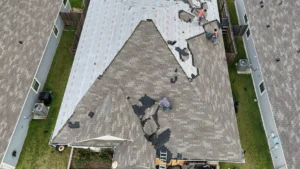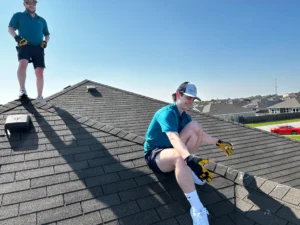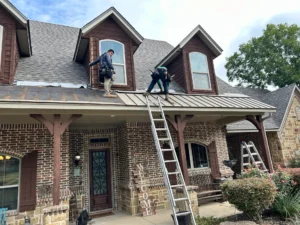
Storms are no strangers to Texas. Whether it’s spring hail in Dallas-Fort Worth, windstorms in Waco, or heavy rain in Austin, the Lone Star State sees its fair share of extreme weather. But what many homeowners don’t realize is that even a storm that seems minor can cause serious roof damage that may not be immediately visible.
So, how do you know if your roof has storm damage—and more importantly, what should you do about it?
In this guide, we’ll break down the signs to look for, why early action matters, and how professional inspections can help protect your home and your wallet.
Why Storm Damage Isn’t Always Obvious
After a storm rolls through, you might be tempted to check your roof from the ground and move on if you don’t see shingles scattered across your lawn. But not all roof damage is obvious to the untrained eye.
Here’s why you should still be cautious:
- Minor hail impacts can bruise or crack shingles, leading to leaks months later.
- Wind uplift can loosen flashing, seals, and shingles, even if they’re not visibly missing.
- Granule loss can compromise the protective coating of shingles, shortening your roof’s lifespan.
In short: no visible damage doesn’t mean no damage at all.
Signs of Storm Damage You Can Spot from the Ground
While a roofing professional should perform a detailed inspection, there are some early warning signs you can check for safely from the ground:
1. Shingles on the Ground
This is a big red flag. Shingles blown off your roof often indicate wind speeds strong enough to compromise the integrity of your roofing system.
2. Dents or Bruises on Shingles
If you’re comfortable using a ladder and taking safety precautions, you might spot:
- Soft spots or bruises
- Cracked or curled shingles
- Missing granules (exposed black mat underneath)
These are common signs of hail impact or wind damage.
3. Granules in Gutters or Downspouts
Granules are the protective top layer on asphalt shingles. If you notice excessive buildup in your gutters, a recent storm may have knocked them loose, leaving your shingles exposed to UV and water damage.
4. Leaking or Water Spots on Ceilings
This usually appears days or weeks after the storm. Water stains, bubbling paint, or moldy odors inside your home suggest roof penetration and should be addressed immediately.
5. Bent or Missing Flashing
Flashing (thin metal used around chimneys, vents, and roof edges) is critical for waterproofing. Wind and debris can bend or dislodge it, leading to leaks in vulnerable areas.
Why Quick Action Matters
Even small amounts of damage can create major headaches later. Here’s why you shouldn’t delay if you suspect roof issues:
1. Insurance Deadlines
In Texas, you typically have one year from the date of the storm to file a claim. Miss that window, and you may be on the hook for full replacement costs—especially if your roof is over 15 years old and only qualifies for ACV (Actual Cash Value) coverage.
2. Hidden Leaks Cause Compounding Damage
Water intrusion doesn’t just affect shingles. It can damage:
- Attic insulation
- Interior walls and ceilings
- Electrical systems
- Structural components
Repair costs multiply quickly the longer the damage goes unnoticed.
3. Future Storms Will Worsen Existing Weaknesses
A roof weakened by one storm is more vulnerable to the next. Addressing minor damage now can prevent full replacement later.
What a Professional Roof Inspection Includes
Many Texas homeowners don’t realize that most reputable roofing companies offer free storm damage inspections. At Vertice Roofing, for example, our inspections include:
- A full evaluation of your shingles, flashing, vents, and chimney
- Documentation with photos for insurance purposes
- A written summary of our findings
- Honest recommendations—repair, replace, or wait
An expert will often spot things you can’t see from the ground, including small hail dents, lifted shingles, or vent damage.
What to Do If You Suspect Storm Damage
If you’re unsure whether your roof sustained damage during a recent storm, here’s a step-by-step plan:
Step 1: Document Everything
Take clear, timestamped photos of your yard, siding, windows, and roof (if safely possible). This can support your insurance claim.
Step 2: Call a Trusted Roofing Contractor
Find a licensed, local roofer—ideally one with experience handling insurance claims. Avoid out-of-town “storm chasers” who pressure you to sign contracts on the spot.
Step 3: Schedule a Roof Inspection
This should be free and no-obligation. A reputable roofer will walk you through their findings, explain next steps, and answer your questions honestly.
Step 4: Contact Your Insurance Company
If damage is found, you’ll want to open a claim right away. Your roofer may even meet your adjuster onsite to ensure nothing is missed.
FAQs About Storm Damage Roofing
Q: My roof looks fine—do I really need an inspection?
Yes. Many forms of storm damage aren’t visible from the ground and may not leak until weeks later.
Q: Can I fix it myself?
DIY repairs are dangerous and often void warranties. Always hire a licensed roofing professional.
Q: How long does a storm damage roof repair take?
Small repairs may take a few hours. Full replacements typically take 1–2 days, weather permitting.
Final Thoughts: Don’t Wait—Get Peace of Mind
Texas weather doesn’t mess around. From Waco to Dallas to Austin, roof damage after a storm is more common than most homeowners realize. But the good news? A professional inspection is free, fast, and the best way to protect your home from future problems.
If you’re unsure whether your roof has been affected, let Vertice Roofing help. Our experienced team will give you honest feedback, walk you through insurance steps, and ensure your home is protected from whatever comes next.




